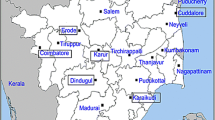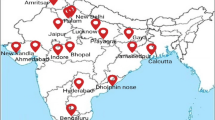Abstract
Wind speed data should be fitted by a suitable statistical model like Weibull to determine expected number of hours per year in the critical wind speed range for a slender structure, which is required to determine the expected number of stress cycles in the projected working life of the structure. Apart from this, for the assessment of wind energy potential wind speed data should be fitted by an appropriate probability distribution. In the present scope of study, wind data of various locations of India have been fitted by Weibull model. Wind speed data are initially sampled in knot by Indian Meteorological Department and later converted into integer km/h before supplying them to the end user. Due to this conversion, wind speed data cannot be properly fitted by Weibull distribution and in this regard, the choice of appropriate class width becomes very much important. Without the choice of appropriate class width, estimated Weibull parameters become biased which would yield incorrect estimation of expected number of hours in critical wind speed ranges as well as wind energy potential. After taking appropriate class width of 4 km/h, it has been found that Weibull model is an adequate model to describe wind speed distributions of India. Weibull model has also been compared with other models such as Gamma and inverse Weibull distributions to establish its suitability than the others. In this study, the values of Weibull shape parameters vary from 1.3 to 2.3, whereas the values of scale parameters vary from 1.4 m/s to 6.5 m/s. The validity of Weibull model is also verified with a target confidence interval of 90%. The uncertainties involved in the estimation of available wind energy potential as well as the expected number of hours per year in critical wind speed ranges have also been considered due to random variation of wind climate in each year.
Similar content being viewed by others
References
Altunkaynak, A., Erdik, T., Dabanlı, İ., and Şen, Z. (2012). “Theoretical derivation of wind power probability distribution function and applications.” Applied Energy, Vol. 92, pp. 809–814, DOI: 10.1016/J.APENERGY.2011.08.038.
Bivona, S., Burlon, R., and Leone, C. (2003). “Hourly wind speed analysis in Sicily.” Renewable Energy, Vol. 28, Issue 9, pp. 1371–1385, DOI: 10.1016/S0960-1481(02)00230-6.
Boudia, S. M., Benmansour, A., Ghellai, N., Benmedjahed, M., and Tabet Hellal, M. A. (2013). “Temporal assessment of wind energy resource at four locations in Algerian Sahara.” Energy Conversion and Management, Vol. 76, pp. 654–664, DOI: 10.1016/J.ENCONMAN. 2013.07.086.
Castillo, E., Hadi, A. S., Balakrishnan, N., and Sarabia, J. M. (2005). Extreme value and related models with applications in engineering and science, Wiely-Interscience, John Wiely & Sons, Inc., New Jersey.
Celik, A. N. (2004). “On the distributional parameters used in assessment of the suitability of wind speed probability density functions.” Energy Conversion and Management, Vol. 45, Issues 11-12, pp. 1735–1747, DOI: 10.1016/j.enconman.2003.09.027.
Coelingh, J. P., Wijk, A. J. M., and Holtslag, A. A. M. (1996). “Analysis of wind speed observations over North Sea.” Journal of Wind Engineering and Industrial Aerodynamics, Vol. 61, Issue 1, pp. 51–69, DOI: 10.1016/0167-6105(96)00043-8.
Cook, N. J. (2001). “Discussion on ‘modern estimation of the parameters of the Weibull wind speed distribution for wind energy analysis’ by J.V. Seguro, T.W. Lambert.” Journal of Wind Engineering and Industrial Aerodynamics, Vol. 89, Issue 10, pp. 867–869, DOI: 10.1016/S0167-6105(00)00088-X.
Deaves, D. M. and Lines, I. G. (1997). “On the fitting of low mean wind speed data to the Weibull distribution.” Journal of Wind Engineering and Industrial Aerodynamics, Vol. 66, Issue 3, pp. 169–178, DOI: 10.1016/S0167-6105(97)00013-5.
Dong, Y., Wang, J., Jiang, H., and Shi, X. (2013). “Intelligent optimized wind resource assessment and wind turbines selection in Huitengxile of Inner Mongolia, China.” Applied Energy, Vol. 109, pp. 239–253, DOI: 10.1016/J.APENERGY.2013.04.028.
Dorvlo, A. S. S. (2002). “Estimating wind speed distribution.” Energy Conversion and Management, Vol. 43, Issue 17, pp. 2311–2318, DOI: 10.1016/S0196-8904(01)00182-0.
EI-Wakil, M. M. (2002). Power plant technology, McGraw-hill International Editions, Electrical and Mechanical Engineering Series.
Fyrippis, I., Axaopoulos, P. J., and Panayiotou, G. (2010). “Wind energy potential assessment in Naxos Island, Greece.” Applied Energy, Vol. 87, Issue 2, pp. 577–586, DOI: 10.1016/J.APENERGY.2009.05.031.
Garcia, A., Torres, J. L., Prieto, E., and Francisco, A. de (1998). “Fitting wind speed distributions: A case study.” Solar Energy, Vol. 62, No. 2, pp. 139–144, DOI: 10.1016/S0038-092X(97)00116-3.
Ghosh, A. (1999). “A FORTRAN program for fitting Weibull distribution and generating samples.” Computers and Geosciences, Vol. 25, Issue 7, pp. 729–738, DOI: 10.1016/S0098-3004(99)00023-0.
Gringorten, I. I. (1963). “A plotting rule for extreme probability paper.” Journal of Geophysical Research, Vol. 68, pp. 813–814, DOI: 10.1029/JZ068i003p00813.
Gupta, B. K. (1986). “Weibull parameters for annual and monthly wind speed distributions for five locations in India.” Solar Energy, Vol. 37, No. 6, pp. 469–471, DOI: 10.1016/0038-092X(86)90039-3.
Harris, R. I. and Cook, N. J. (2014). “The parent wind speed distribution: Why Weibull?.” Journal of Wind Engineering and Industrial Aerodynamics, Vol. 131, pp. 72–87, DOI: 10.1016/J.JWEIA.2014. 05.005.
IS: 4998 (Part I)-1975, Criteria for design of reinforced concrete chimneys: Part 1 Design criteria, New Delhi.
Jaramillo, O. A. and Borja, M. A. (2004). “Wind speed analysis in La Ventosa, Mexico: A bimodal probability distribution case.” Renewable Energy, Vol. 29, Issue 10, pp. 1613–1630, DOI: 10.1016/j.renene.2004.02.001.
Jowder, F. A. L. (2009). “Wind power analysis and site matching of wind turbine generators in Kingdom of Bahrain.” Applied Energy, Vol. 86, Issue 4, pp. 538–545, DOI: 10.1016/J.APENERGY.2008.08.006.
Kasperski, M. (2000). Specification and codification of design wind loads, Habilitation Thesis, Ruhr-Universität Bochum, Germany.
Kasperski, M. (2009). “Specification of the design wind load-a critical review of code concepts.” Journal of Wind Engineering and Industrial Aerodynamics, Vol. 97, Issues 7-8, pp. 335–357, DOI: 10.1016/j.jweia.2009.05.002.
Khan, B. H. (2006). Non-conventional energy resources, Tata McGraw-Hill Publishing Company Limited, New Delhi.
Li, J., Li, C., He, L., and Shen, J. (2015). “Extended modulating functions for simulation of wind velocities with weak and strong nonstationarity.” Renewable Energy, Vol. 83, Issue 11, pp. 384–397, DOI: 10.1016/j.renene.2015.04.044.
Lun, I. Y. F. and Lam, J. C. (2000). “A study of Weibull parameters using long term wind observations.” Renewable Energy, Vol. 20, Issue 2, pp. 145–153, DOI: 10.1016/S0960-1481(99)00103-2.
Mpholo, M., Mathaba, T., and Letuma, M. (2012). “Wind profile assessment at Masitise and Sani in Lesotho for potential off-grid electricity generation.” Energy Conversion and Management, Vol. 53, Issue 1, pp. 118–127, DOI: 10.1016/J.ENCONMAN.2011.07.015.
Ramirez, P. and Carta, J. A. (2005). “Influence of the data sampling interval in the estimation of the parameters of the Weibull wind speed probability density distribution: A case study.” Energy Conversion and Management, Vol. 46, pp. 2419–2438, DOI: 10.1016/j.enconman. 2004.11.004.
Rehman, S., Halawani, T. O., and Husain, T. (1994). “Weibull parameters for wind speed distribution in Saudi Arabia.” Solar Energy, Vol. 53, No. 6, pp. 473–479, DOI: 10.1016/0038-092X(94)90126-M.
Seguro, J. V. and Lambert, T. W. (2000). “Modern estimation of the parameters of the Weibull wind speed distribution for wind energy analysis.” Journal of Wind Engineering and Industrial Aerodynamics, Vol. 85, Issue 1, pp. 75–84, DOI: 10.1016/S0167-6105(99)00122-1.
Shu, Z. R., Li, Q. S., and Chan, P. W. (2015). “Investigation of offshore wind energy potential in Hong Kong based on Weibull distribution function.” Applied Energy, Vol. 156, pp. 362–373, DOI: 10.1016/J.APENERGY.2015.07.027.
Sulaiman, M. Y., Akaak, A. M., Wahab, M. A., Zakaria, A., Sulaiman, Z. A., and Suradi, J. (2002). “Wind characteristic of Oman.” Energy, Vol. 27, Issue 1, pp. 35–46, DOI: 10.1016/S0360-5442(01)00055-X.
Ucar, A. and Balo, F. (2009). “Investigation of wind characteristics and assessment of wind-generation potentiality in Uludağ-Bursa, Turkey.” Applied Energy, Vol. 86, Issue 3, pp. 333–339, DOI: 10.1016/J.APENERGY.2008.05.001.
Ucar, A. and Balo, F. (2009). “Evaluation of wind energy potential and electricity generation at six locations in Turkey.” Applied Energy, Vol. 86, Issue 10, pp. 1864–1872, DOI: 10.1016/J.APENERGY. 2008.12.016.
Zaharim, A., Razali, A. M., Abidin, R. Z., and Sopian, K. (2009). “Fitting of statistical distributions to wind speed data in Malaysia.” European Journal of Scientific Research, Vol. 26, No. 1, pp. 6–12.
Author information
Authors and Affiliations
Corresponding author
Rights and permissions
About this article
Cite this article
Sarkar, A., Gugliani, G. & Deep, S. Weibull model for wind speed data analysis of different locations in India. KSCE J Civ Eng 21, 2764–2776 (2017). https://doi.org/10.1007/s12205-017-0538-5
Received:
Revised:
Accepted:
Published:
Issue Date:
DOI: https://doi.org/10.1007/s12205-017-0538-5




